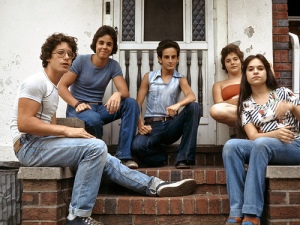 There is a section in Bowling Alone on how homeowners are more involved civicly than renters. Barry Bluestone, Dean of the School of Public Policy and Urban Affairs, at Northeastern University, was speaking to the Harvard Kennedy School Inequality Program today on “Is Homeownership Now Just a Dream?” Among discussions of who benefits from homeownership, he discussed whether we should support it and raised the issue of whether homeowners are better citizens, and if so, is it just due to their longer tenure in neighborhoods. Excerpt from his draft paper:
There is a section in Bowling Alone on how homeowners are more involved civicly than renters. Barry Bluestone, Dean of the School of Public Policy and Urban Affairs, at Northeastern University, was speaking to the Harvard Kennedy School Inequality Program today on “Is Homeownership Now Just a Dream?” Among discussions of who benefits from homeownership, he discussed whether we should support it and raised the issue of whether homeowners are better citizens, and if so, is it just due to their longer tenure in neighborhoods. Excerpt from his draft paper:
“To test the assertions made in the literature, we conducted our own analysis using data collected through the National Survey of Families and Households (NSFH) fielded in 2001/2002….In our analysis of the NSFH data, it was possible to investigate the impact of homeownership on a range of factors including the respondent’s optimism about their own life circumstances; on church attendance; on getting together with neighbors; on participation in group recreational activities; on the time they spend in local sports, hobby and discussion groups; and in the number of times they participate in the activities of local service clubs, fraternal organizations and political groups…. Essentially, this [our] analysis asks the following question: if renters had the same income, age, education, and residential tenure as homeowners, would they be as optimistic about their own lives and be as civically-engaged as exisitng homeowners? Again, is there any benefit to homeownership per se? The results of this new analysis point to a number of individual and social benefits that accrue to homeowners even when compared to renters who have lived in the same place for nearly ten years and have equivalent social-economic status (SES) – income, education, and age. On the one hand, the analysis finds no difference between homeowners and renters in church attendance, in getting together with friends, or in participating in group recreational activities. On the other, homeowners tend to be more optimistic about their own futures, they participate more often in local sports and discussion groups, and most importantly they are more civically engaged in service organizations, fraternal groups, and political organizations… Before controlling for housing tenure and SES, 48.3% of homeowners report that they participated in sports, hobby, or discussion groups at least once a year; only 37.9% of renters reported such. After controlling for these factors, the probability of renters participating in these activities increases to 39.8%. Hence, homeownership per se appears to boost such participation by 8.5 percentage points or by more than 21 percent. Before controlling for housing tensure and SES, 37.5% of homeowners but only 27.2% of renters responded that they participated at least once a year in service clubs, fraternal organizations, or political groups. After controlling for tenure and SES, renter participation appears to increase to 31.5%, still 6 percentage points less than homeowners. That is, homeowners are 19 percent more likely to be active in these groups.
Bluestone seems sympathetic to homeownership. His analysis is interesting but despite his effort to be “fair”, he likely overcontrols since he makes the highly unlikely assumption that one could have considerable number of renters with the same tenure as homeowners. One thing that Bluestone didn’t examine is how renters and buyers differ in their future intentions of rootedness and geographic mobility: only 25% of homeowners, when we conducted research for Bowling Alone, expected to move in the next five years versus two-thirds of renters. If we had policies in America that left us with far more renters, it seems wishful thinking to imagine that most of them would remain in community for as long as the owners. And thus even on the measures where Bluestone doesn’t find that homeownership is associated with higher levels of engagement after his demographic controls (namely, socializing and church attendance), homownership probably really is still associated with higher socializing and church attendance. Homeownership works to increase rootedness (partly psychologically and partly financially) and this rootedness increases socializing and church attendance.
Bluestone also relayed an interesting and telling anecdote about his hometown of Detroit. Albert Cobo (Mayor of Detroit in the early 1950s) used the power of eminent domain to raze a poor community in downtown Detroit to prepare for highway expansion that never occurred. After the highway fell through, African-Americans’ hopes that the razed area would soon be rebuilt, the suburbs of Detroit were developed, but the area razed by Cobo remained vacant. Eventually the UAW developed a significant tract of housing in the razed area but insisted that all the homes be rental units. Edison developed a community across the street, even hiring the same architect to give the other community the same look and feel. Bluestone notes that while these areas (the UAW rental tract and the Edison ownership tract) attracted similar residents, the Edison (home-owned) units have remained in much better condition as the owners have worked to preserve their investments and volunteered for neighborhood groups that preserved the more general environment. My guess, although Bluestone didn’t say this, is that residential tenure was also much longer in the Edison ownership tract than in the UAW rental one.



